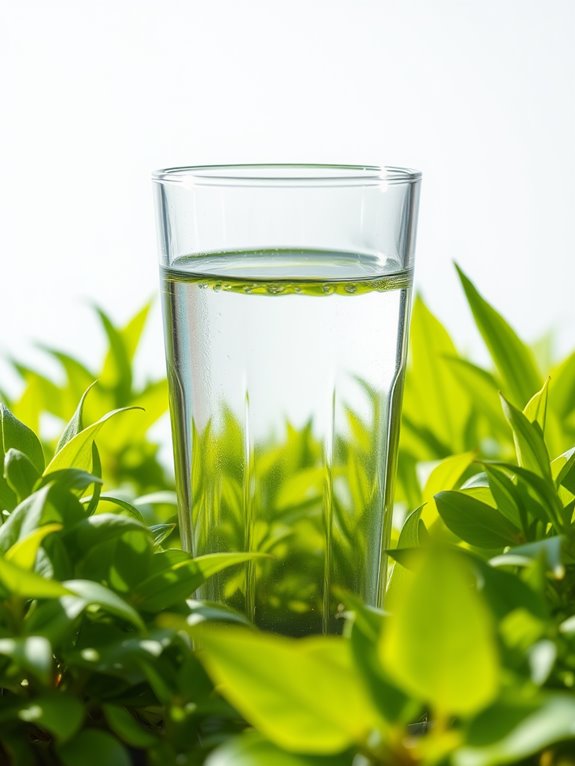Water treatment is vital for your daily water safety and quality. It involves processes like coagulation, filtration, and disinfection to remove harmful contaminants, ensuring clean drinking water. Access to safe water protects your health by reducing the risk of diseases like infections and gastrointestinal issues. Adequate treatment also promotes a healthier community and environment. With ongoing challenges like aging infrastructure and climate change, understanding these processes is essential, and there’s much more to uncover about water treatment’s impact.
Understanding Water Treatment Processes

When you think about water treatment processes, it’s crucial to understand that they play an important role in ensuring the safety and quality of our water supply.
These processes involve various stages, including coagulation, sedimentation, filtration, and disinfection. Each step helps remove impurities, harmful microorganisms, and pollutants, making water safe for consumption.
By utilizing these techniques, you contribute to a healthier environment and protect public health.
It’s important to recognize the significance of maintaining these processes, as they directly impact your daily life and well-being.
Understanding how water treatment works empowers you to appreciate and advocate for clean water initiatives.
You might also be interested in: What Does a Plumber do on Daily Basis?
Types of Water Contaminants
When it comes to water quality, understanding the types of contaminants is essential.
You’ll encounter biological contaminants like bacteria and viruses, as well as various chemical contaminants that can affect health and the environment.
Recognizing these threats helps you appreciate the importance of effective water treatment.
Biological Contaminants Overview
Biological contaminants, which include bacteria, viruses, and parasites, pose significant risks to water safety and human health. Understanding these contaminants is vital for effective water treatment. Here’s a quick overview of common types:
| Contaminant Type | Health Effects | Sources |
|---|---|---|
| Bacteria | Gastroenteritis | Contaminated sources |
| Viruses | Respiratory issues | Infected humans |
| Parasites | Diarrhea, nausea | Animal waste |
| Protozoa | Intestinal illness | Untreated water |
| Pathogens | Severe infections | Poor sanitation |
Chemical Contaminants Types
Chemical contaminants in water can be just as dangerous as biological ones, affecting both health and the environment.
You may encounter various types of chemical contaminants, including heavy metals like lead and mercury, which can cause serious health issues.
Pesticides and herbicides, often from agricultural runoff, can also pollute water sources, posing risks to wildlife and human health.
Industrial chemicals, such as solvents and oils, can leach into water systems, further complicating treatment efforts.
Understanding these contaminants helps you appreciate the need for effective water treatment methods to guarantee safe drinking water and protect our ecosystems.
Importance of Clean Water for Health

Access to clean water is essential for maintaining good health, as it directly affects your well-being and quality of life. Contaminated water can lead to numerous health issues, including gastrointestinal diseases, cholera, and other infections. Staying hydrated with clean water boosts your immune system, aids digestion, and promotes healthy skin. It’s vital to understand the impact of water quality on your health.
| Health Aspect | Impact of Clean Water | Consequences of Contaminated Water |
|---|---|---|
| Immune System | Strengthens | Increased illness risk |
| Digestion | Aids absorption | Digestive disorders |
| Skin Health | Promotes clarity | Skin infections |
| Hydration | Maintains balance | Dehydration |
| Overall Well-being | Enhances quality of life | Chronic health issues |
Common Water Treatment Methods
When it comes to ensuring your water is safe, understanding common treatment methods is key.
You’ll find that filtration techniques and chemical treatment processes play essential roles in purifying water.
Let’s explore how these methods work together to provide clean, drinkable water.
Filtration Techniques Overview
While many methods exist for purifying water, filtration techniques stand out as crucial components in the treatment process. These methods effectively remove impurities, ensuring you have clean and safe water.
Here are four common filtration techniques you should know:
- Sand Filtration: Uses layers of sand to trap particles and contaminants.
- Activated Carbon: Absorbs chemicals and odors, improving taste and smell.
- Membrane Filtration: Employs a semi-permeable membrane to separate contaminants at a microscopic level.
- Reverse Osmosis: Forces water through a membrane, removing even the smallest impurities.
These techniques are fundamental in delivering clean drinking water.
Chemical Treatment Processes
Filtration techniques serve as an essential first step in ensuring water safety, but chemical treatment processes play an equally important role in water purification. By adding chemicals like chlorine, you can effectively eliminate harmful bacteria and viruses.
Coagulation and flocculation are also critical; these processes help clump impurities together for easier removal. Additionally, pH adjustments can enhance the effectiveness of these treatments.
You might also encounter advanced oxidation processes, which break down organic contaminants. Understanding these chemical methods allows you to appreciate their significance in producing clean, safe water, ensuring your health and that of your community.
The Role of Water Treatment in Environmental Protection

Although many people may not realize it, water treatment plays an essential role in safeguarding our environment. By ensuring clean water, you help protect ecosystems and public health.
Here are four key ways water treatment contributes to environmental protection:
- Reduces Pollution: It filters out harmful contaminants, preventing them from entering waterways.
- Conserves Resources: Treated water can be reused, reducing the demand on natural sources.
- Supports Biodiversity: Clean water fosters healthy habitats for aquatic life.
- Enhances Sustainability: Efficient treatment processes minimize waste and energy use, promoting a cleaner planet.
Every drop counts in this crucial process!
Water Treatment in Industrial Applications
Water treatment is essential in industrial applications, with over 20% of global water consumption attributed to various industries. Proper treatment guarantees that water meets safety and quality standards, reducing harmful impacts on equipment and the environment. You’ll find various methods tailored for specific needs, from cooling water systems to wastewater treatment.
| Treatment Type | Key Benefits |
|---|---|
| Filtration | Removes particulates |
| Chemical Treatment | Destroys contaminants |
| Reverse Osmosis | Purifies water effectively |
| Ion Exchange | Softens hard water |
| UV Disinfection | Kills pathogens quickly |
Innovations in Water Treatment Technology

As industries face increasing demands for cleaner and more efficient processes, innovations in water treatment technology are playing an essential role in meeting these challenges.
You’ll find that these advancements can greatly enhance water quality and reduce operational costs.
Here are four key innovations worth noting:
- Membrane Filtration – Efficiently removes contaminants at a molecular level.
- Advanced Oxidation Processes – Degrades organic pollutants effectively.
- Biological Treatment Systems – Utilize microorganisms to purify wastewater.
- Smart Sensors – Monitor water quality in real-time for proactive management.
Embracing these technologies can lead to sustainable practices and improved compliance with regulations.
Challenges in Water Treatment and Management
While advancements in technology have improved water treatment processes, significant challenges still persist in managing water resources effectively.
You’ll face issues like aging infrastructure, which can lead to leaks and contamination. Additionally, fluctuating regulations complicate compliance, making it tough to keep up with standards.
Climate change impacts water availability, causing scarcity in some areas and flooding in others. Public awareness and engagement are often low, hindering community support for necessary investments.
Finally, funding limitations restrict innovation and improvement in water treatment facilities. Addressing these challenges is vital for ensuring clean, safe water for everyone.
Conclusion
In today’s world, clean water isn’t just a luxury; it’s a necessity. You’ve learned how crucial water treatment is for health and the environment, shaping a future where everyone has access to safe drinking water. Remember, just like our ancestors fought for clean rivers, we must continue that fight today. By supporting innovative water treatment solutions, you can help guarantee that future generations thrive. Together, let’s protect this precious resource—because every drop counts!

I’m Allen Kim, the chief editor of plumbinginto. I am a mid level plumber and assign to an local firm over 4 years of experience. During the working period, most of my experience is related to the house plumbing. I learned about the thing, when working with most experienced people in this sector, one must be as good as the inspector or better with knowledge of the project as well as the practical aspects of plumbing industry.